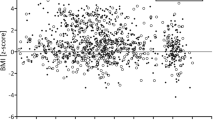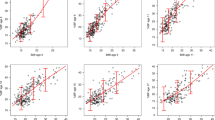Abstract
Aim
The objective of this study is to generate metabolic phenotypes based on structure–function relationships.
Methods
In 459 healthy adults (54% females, 18 and 40 years old), we analyzed body composition by air-displacement densitometry (to assess fat mass, (FM) and fat-free mass (FFM)) and whole-body magnetic resonance imaging (to assess skeletal muscle mass (SMM) and masses of brain, heart, liver, kidneys, and subcutaneous (SAT) and visceral adipose tissue (VAT)), resting energy expenditure (REE) by indirect calorimetry, and plasma concentrations of insulin (Ins) and leptin (Lep).
Results
Three “functional body composition-derived phenotypes” (FBCPs) were derived: (1) REE on FFM-FBCP, (2) Lep on FM-FBCP, and (3) Ins on VAT-FBCP. Assuming that being within the ± 5% range of the respective regression lines reflects a “normal” structure–function relationship, three “normal” FBCPs were generated with prevalences of 9.0%, 5.1%, and 6.8%, respectively, of the study population. The three “FBCPs” did not overlap and were independent from each other. When compared with the two other FBCPs, the “Lep on FM-FBCP” was leanest, whereas the “REE on FFM-FBCP” had the highest BMI and SAT. Taking into account FFM composition, a hierarchical multi-level model is proposed with brain at level 1, the liver at level 2, and SMM and FM at level 3 with insulin coordinating the interplay between level 1 and 2, whereas variance in plasma insulin levels impacts energy and substrate metabolism in SMM and AT.
Conclusion
Structure–function relationships can be used to generate FBCPs. Different FBCPs reflect different dimensions of normality (or health). This is evidence for the idea that there is no across the board “normal” state.
This is a preview of subscription content, access via your institution
Access options
Subscribe to this journal
Receive 12 print issues and online access
$259.00 per year
only $21.58 per issue
Buy this article
- Purchase on Springer Link
- Instant access to full article PDF
Prices may be subject to local taxes which are calculated during checkout




Similar content being viewed by others
References
Franks PW, Pearson E, Florez JC. Gene-environment gene-treatment interactions in type 2 diabetes mellitus: progress, pitfalls, and prospects. Diabetes Care. 2013;36:1413–21.
Blundell J, Dulloo AG, Salvador J, Frühbeck G.on behalf of the EASO SAB Working Group on BMI Beyond BMI-phenotyping the obesities. Obes Facts. 2014;7:322–8.
Müller MJ, Braun W, Enderle J, Bosy-Westphal A. Beyond BMI: Conceptual issues related to overweight and obese patients. Obes Facts. 2016;9:193–205.
Gonzalez MC, Correia MITD, Heymsfield SB. A requiem for BMI in the clinical setting. Curr Opin Clin Nutr Metab Care. 2017;20:314–21.
Manrai AK, Patel CJ, Ioannides JP. In the era of precision medicine and big data, who is normal? JAMA. 2018;319:1981–2.
Bosy-Westphal A, Deurenberg P, Müller MJ. Body composition. Human Nutrition. London: NutritionSociety Textbooks, Nutriton Society; 2018.
Prado CM, Heymsfield SB. Lean tissue imaging: a new era for nutritional assessment and intervention. J Par Enter Nutr. 2014;2014:940–53.
Ahima RS, Lazar MA. Physiology. The health risk of obesity-better metrics imperative. Science. 2013;341:856–8.
Prado CM, Siervo M, Mire E, Heymsfield SB, Stephan BC, Broyles S, et al. A population-based approach to define body-composition phenotypes. Am J Clin Nutr. 2014;99:1369–77.
Bosy-Westphal A, Müller MJ. Identification of skeletal muscle mass depletion across age and BMI groups in health and disease--there is need for a unified definition. Int J Obes. 2015;39:379–86.
Müller MJ, Geisler C, Pourhassan M, Glüer CC, Bosy-Westphal A. Assessment and definition of lean body mass deficiency in the elderly. Eur J Clin Nutr. 2014;68:1220–7.
Linge J, Borga M, West J, Tuthill T, Miller MR, Thomas EL, et al. Body composition profiling in the UK Biobank Imaging Study. Obesity (Silver Spring). 2018. https://doi.org/10.1002/oby.22210.
Müller MJ. From BMI to functional body composition. Eur J Clin Nutr. 2013;67:1119–21.
Müller MJ, Braun W, Pourhassan M, Geisler C, Bosy-Westphal A. Application of standards and models in body composition analysis. Proc Nutr Soc. 2016b;75:181–7.
Müller MJ, Geisler C, Heymsfield SB, Bosy-Westphal A. Recent advances in understanding body weight homeostasis in humans. F1000Res. 2018;7:F1000 Faculty Rev:1025 https://doi.org/10.12688/f1000research.14151.1)
Müller MJ, Langemann D, Gehrke I, Later W, Heller M, Glüer CC, et al. Effect of constitution on mass of individual organs and their association with metabolic rate in humans - a detailed view on allometric scaling. PLoS ONE. 2011;7:e22732.
Bosy-Westphal A, Braun W, Schautz B, Müller MJ. Issues in characterizing energy expenditure in obesity and after weight loss. Front Physiol. 2013;4:47.
Geisler C, Braun W, Pourhassan M, Schweitzer L, Glüer CC, Bosy-Westphal A, et al. Gender-specific association in age-related changes in resting energy expenditure (REE) and MRI-mesasured body composition in healthy Caucasians. J Gerontol A Biol Sci Med Sci. 2015;94:1–6.
Gallagher D, Elia M. Body composition, organ mass, and resting energy expenditure. In: Heymsfield SB, Lohman TG, Wang Z, Going SB, editors. Human Body Composition. 2nd ed. Champaign, IL: Human Kinetics; 2005.
Müller MJ, Enderle J, Pourhassan M, Braun W, Eggeling B, Lagerpusch M, et al. Metabolic adaptation to caloric restriction and subsequent refeeding: the Minnesota Starvation Experiment revisited. Am J Clin Nutr. 2015;102:807–19.
Geisler C, Schweitzer L and Müller MJ. Functional correlates of detailed body composition in healthy elderly subjects. J Appl Physiol. 2017: jap.00162.2017 https://doi.org/10.1152/japplphysiol.00162.2017.
Müller MJ, Geisler C and Bosy-Westphal A. Body composition. In Encyclopedia of Endocrine Diseases (Mancini L, editor). 2nd ed. NY: Academic Press, Elsevier; 2018 (in press).
Müller MJ, Geisler C, Hübers M, Pourhassan M, Braun W, Bosy-Westphal A. Normalizing resting energy expenditure across the life course in humans: challenges and hopes. Eur J Clin Nutr. 2018;72:628–37.
Müller MJ, Wang Z, Heymsfield SB, Schautz B, Bosy-Westphal A. Advances in the understanding of specific metabolic rates of major organs and tissues in humans. Curr Opin Clin Nutr Metab Care. 2013;16:501–8.
Peters A, Langemann D. Build-ups in the supply chain of the brain: on the neuroenergetic cause of obesity and type 2 diabetes mellitus. Front Neuroenergetics. 2009;1:2 https://doi.org/10.3389/neuro.14.002.2009. Apr 28; eCollection 2009
Peters A, Hitze B, Langemann D, Bosy-Westphal A, Müller MJ. Brain size, body size and longevity. Int J Obes. 2010;34:1349–52.
Acknowledgements
The study was funded by a grant of the German Ministry of Education and Research (BMBF 0315681), BMBF Competence Network Obesity (CNO; BMBF 01GI1125), and the German Research Foundation (DFG Bo 3296/1–1 and DFG Mü 714/ 8–3).
Author information
Authors and Affiliations
Corresponding author
Ethics declarations
Conflict of interest
The authors declare that they have no conflict of interest.
Rights and permissions
About this article
Cite this article
Müller, M.J., Geisler, C., Hübers, M. et al. Body composition-related functions: a problem-oriented approach to phenotyping. Eur J Clin Nutr 73, 179–186 (2019). https://doi.org/10.1038/s41430-018-0340-6
Received:
Accepted:
Published:
Issue Date:
DOI: https://doi.org/10.1038/s41430-018-0340-6
This article is cited by
-
Advances in body composition: a 100-year journey
International Journal of Obesity (2024)
-
Being a scientist
European Journal of Clinical Nutrition (2023)
-
Predictors of non-alcoholic fatty liver disease in children
Pediatric Research (2022)
-
Issues in Measuring and Interpreting Human Appetite (Satiety/Satiation) and Its Contribution to Obesity
Current Obesity Reports (2019)
-
Effect of Over- and Underfeeding on Body Composition and Related Metabolic Functions in Humans
Current Diabetes Reports (2019)



